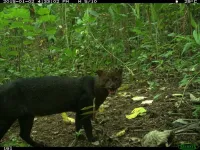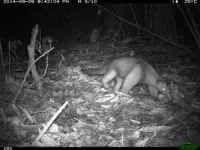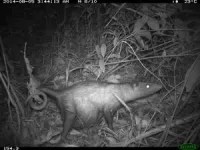(Press-News.org) In the fight to mitigate climate change and deforestation in the tropics, timber plantations have emerged as a promising strategy for reforesting degraded land and connecting patches of natural forest. Often, these are species with commercial value for landowners but are not native to the region. To evaluate how well non-native tree plantations support native wildlife in heavily human-impacted areas, researchers from the Smithsonian Tropical Research Institute (STRI), the Max Planck Institute of Animal Behavior (MPI-AB), Wageningen University & Research, and the University of California – Davis surveyed over 200 hectares of timber plantations in Central Panama for one year.
The team set camera traps—cameras with motion sensors— in small-scale timber plantations in Central Panama, the narrowest tract of land on the American continent. Centered around Nuevo San Juan, Colon, within the Panama Canal Watershed, the study area featured a diverse mosaic of timber plantation types, human settlements, agricultural fields, and road networks. This region is critical for maintaining connectivity within the Mesoamerican Biological Corridor, facilitating movement for medium and large mammals like jaguars, pumas, coatis, tapirs, anteaters, and peccaries between Soberania National Park to the west and Chagres National Park to the east.
The researchers wanted to find out if terrestrial mammal species, including those of conservation concern, used the timber plantations in the area, either as habitats or as corridors to access natural forest fragments. They also wanted to know if the type of timber planted had any effect on whether the mammals used the plantations.
While working at STRI before his doctoral studies at MPI-AB, lead author Claudio Monteza started the camera trap study to find out more about biodiversity in unprotected forests.
“Most conservation efforts are focused on protected areas, so we wanted to know how wildlife was faring in the many unprotected forests of Panama,” says the Panamanian scientist.
The team installed camera traps in five plantation types. Four were monocultures of the non-native timber trees teak, cedro, melina and acacia; one was a mix of native and non-native trees. Cameras on 79 sites collected data for a year, representing 3165 camera-trapping days.
Their analyses of the images found that 16 terrestrial mammal species, mostly small or medium in size and nocturnal, were using the plantations. Three of these species, the greater grison, jaguarundi and northern naked-tailed armadillo, are particularly elusive and sightings are rare even in natural forests. However, no large mammals of conservation concern were detected. These results provide a rare glimpse into the state of wildlife on plantations and reveal their potential use as habitat or corridors for smaller mammals.
Although the findings could not reveal whether animals were using plantations as homes or merely passing through them, Monteza was still surprised by what he found.
“Clearly these plantations do not have the right resources to sustain large mammals,” he says. “I remember vividly how during one-year of fieldwork, I only observed agoutis and coatis. So, it was heartening to find 16 native species of mammals using the land. Even if these areas are so impacted by human activity and far from protected forest”.
However, not all plantations supported wildlife equally. Teak monocultures, which account for as much as 65% of the timber plantations in Panama, showed the lowest records of species compared to other plantation types.
In essence, while timber plantations provide some conservation benefits for smaller mammals by acting as corridors and refuges, their limitations in supporting large-bodied mammals of conservation concern highlight the importance of restoring natural habitats for comprehensive wildlife conservation efforts.
"Policy makers should realize that reforestation with monocultures of exotic species does not necessarily aid wildlife conservation," says co-author Patrick Jansen, from Wageningen University and STRI.
However, co-author Jefferson Hall from STRI believes the glass is still half full. “Given that these plantations are in a sea of humanity, the fact that any small mammals were found here shows plantations can play a role as buffer zones for protected areas and corridors”.
The authors caution that their study provides only a snapshot of the biodiversity present in Panama’s timber plantations. Future studies should look at a diversity of plantations across the landscape to assess plantation conservation value writ large. For the team, these results are a first step in understanding the role of plantations for Panama’s native fauna.
“These results are valuable for sustainable forestry practices,” says Monteza. “It tells us what tree species strike the balance of supporting biodiversity as well as the livelihoods of private landowners. I hope decision-makers take into consideration small-scale private landholders for management plans.”
Fieldwork for this study was funded by a grant from Argos Panamá S.A. as part of the Agua Salud Project.
Headquartered in Panama, the Smithsonian Tropical Research Institute is a unit of the Smithsonian Institution in Washington, DC. The institute furthers the understanding of tropical biodiversity and its importance to human welfare, trains students to conduct research in the tropics and promotes conservation by increasing public awareness of the beauty and importance of tropical ecosystems.
END
Timber plantations near urbanized areas support the movement of small and medium-sized terrestrial mammals between patches of natural forest
2024-07-29
ELSE PRESS RELEASES FROM THIS DATE:
Wang receives funding for Experiential Learning Program
2024-07-29
Wang Receives Funding For Experiential Learning Program
Zhengdao Wang, Professor, Cybersecurity Engineering, College of Engineering and Computing (CEC), received $14,000 from Old Dominion Research Foundation for: “CCI—2024 Experiential Learning Program/Water System Infrastructure - Innovative Experiential Learning.”
Wang intends to enhance awareness and understanding of cybersecurity risks associated with public water systems by developing an educational simulation game, "CyberShield H2O."
He will provide ...
Everyday activities aren’t enough to protect against stroke
2024-07-29
Research conducted at the University of Gothenburg shows that the physical activities we do as we go about our lives, at work or in the home, aren’t enough to protect us from having a stroke. However, exercising in our free time and using active modes of transport are associated with a decreased risk of stroke.
“Physical activity during leisure time and as transportation is becoming increasingly important now that many jobs and domestic activities are becoming more sedentary,” says lead ...
Deciphering the role of mitochondrial DNA targeted therapy in hepatic cell carcinoma
2024-07-29
Hepatic cell carcinoma (HCC), the fifth most prevalent malignancy worldwide and the fourth leading cause of cancer-related mortality, poses significant therapeutic challenges. Despite advancements in medical research, late-stage HCC patients have a dismal five-year survival rate of less than 20%. The complexity of liver cancer development involves an intricate interplay of genetic and environmental factors. Among these, mitochondrial alterations and mutations in mitochondrial DNA (mtDNA) are increasingly recognized as critical contributors to cancer pathogenesis. These changes not only impair cellular bioenergetics ...
Projected changes in statin and antihypertensive therapy eligibility with the AHA PREVENT cardiovascular risk equations
2024-07-29
About The Study: By assigning lower atherosclerotic cardiovascular disease risk predictions, application of the Predicting Risk of cardiovascular disease EVENTs (PREVENT) equations to existing treatment thresholds could reduce eligibility for statin and antihypertensive therapy among 15.8 million U.S. adults.
Corresponding Author: To contact the corresponding author, Arjun K. Manrai, Ph.D., email Arjun_Manrai@hms.harvard.edu.
To access the embargoed study: Visit our For The Media website at this link https://media.jamanetwork.com/
(doi:10.1001/jama.2024.12537)
Editor’s ...
Losing a loved one may speed up aging, study finds
2024-07-29
Losing someone close, like a family member, can make you age faster, says a new study from Columbia University Mailman School of Public Health and the Butler Columbia Aging Center. The study found that people who lost a parent, partner, sibling, or child, showed signs of older biological age compared to those who hadn’t experienced such losses. The research was published in JAMA Network Open.
Biological aging is the gradual decline in how well your cells, tissues, and organs function, leading to a higher risk of chronic diseases. Scientists measure this type of aging using DNA markers known as epigenetic clocks.
“Few studies ...
Maternal obesity and risk of sudden unexpected infant death
2024-07-29
About The Study: The findings of this study suggest that infants born to mothers with obesity are at increased risk of sudden unexpected infant death (SUID), with a dose-dependent association between increasing maternal body mass index and SUID risk. Maternal obesity should be added to the list of known risk factors for SUID. With maternal obesity rates increasing, research should identify potential causal mechanisms for this association.
Corresponding Author: To contact the corresponding author, Darren Tanner, Ph.D., email darren.tanner@microsoft.com.
To access the ...
Fecal microbiota transplantation for treatment of Parkinson disease
2024-07-29
About The Study: Fecal microbiota transplantation (FMT) was safe but did not offer clinically meaningful improvements. Further studies—for example, through modified FMT approaches or bowel cleansing—are warranted regarding the specific impact of donor microbiota composition and dysbiosis conversion on motor and nonmotor outcomes as well as medication needs in Parkinson disease.
Corresponding Author: To contact the corresponding author, Filip Scheperjans, M.D., Ph.D., email filip.scheperjans@hus.fi.
To access the embargoed study: Visit our For The Media website at this link https://media.jamanetwork.com/
(doi:10.1001/jamaneurol.2024.2305)
Editor’s ...
Advancing health disparities science through social epigenomics research
2024-07-29
About The Article: The studies highlighted in this special issue of JAMA Network Open demonstrate important scientific progress in the complex integration of social determinants of health and health disparities with biological pathways and health outcomes to improve understanding of the mechanisms underlying health disparities among various underserved populations. Continued progress remains important in integrating different disciplines to transform the field of health disparities research.
Corresponding Author: To contact the corresponding author, Arielle S. Gillman, Ph.D., M.P.H., email arielle.gillman@nih.gov.
To ...
Advanced ‘Parkinson's in a dish’ model accelerates brain disease research
2024-07-29
Researchers at Brigham and Women’s Hospital, a founding member of the Mass General Brigham healthcare system, have developed a model that rapidly converts stem cells to brain cells with protein structures characteristic of Parkinson’s disease (PD), enabling the study of the condition’s unique and highly variable disease pathology in a petri dish. The study details how the model can one day be used to develop personalized diagnostic and treatment methods for Parkinson’s disease. Results are published in Neuron.
“We sought to assess how quickly we could ...
What will the new cardiovascular risk calculator mean for patients?
2024-07-29
A recently unveiled cardiovascular disease risk calculator that measures a patient’s risk for heart attack and stroke is better calibrated and more precise than its previous version, but if current treatment guidelines for cholesterol and blood pressure therapy remain unchanged, the new calculator may have unintended consequences, according to research from Harvard Medical School.
The analysis, published July 29 in JAMA, estimates that the new risk calculator would render nearly 16 million people newly ineligible under current treatment thresholds that guide clinical decisions about who should get cholesterol ...



